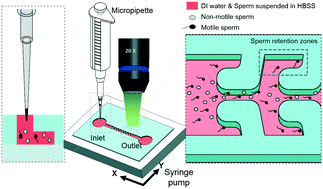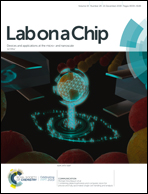Microfluidic retention of progressively motile zebrafish sperms†
Abstract
Genetic manipulation of zebrafish results in thousands of mutant strains and to efficiently preserve them for future use, zebrafish sperms have been cryopreserved in various cryopreservation centers. However, cryopreservation protocols are known to alter genetic entities. Therefore, there is an urgent need for an efficient method that can select morphologically superior and progressively motile zebrafish sperms after their activation for in vitro fertilization success. However, unlike those of other mammalian species, fish sperms do not take any physical or chemical cues to travel towards the egg. Their inertness towards any external cues makes the control of their orientation in a microfluidic environment difficult. In this aspect, a new microfluidic concept was demonstrated where PDMS baffles were inserted in the sidewalls to form microscale confinement creating a flow stagnation zone towards sperm retention. Two distinct microfluidic device designs were selected to evidence the improvement in sperm retention through the unique hydrodynamic feature provided by the microchannel design. Under similar flow conditions, 44% improvement was noticed for the device with a modified baffle design in terms of sperm retrieving efficiency. It was further noticed that with a flow tuning of 0.7 μL min−1, 80% of the total sperms swimming into the retention zones was retained within a specific time window. The present work further explains the significance of the hydrodynamic dependency of zebrafish sperm kinematics that paves the way for highly efficient spermatozoan manipulation.



 Please wait while we load your content...
Please wait while we load your content...